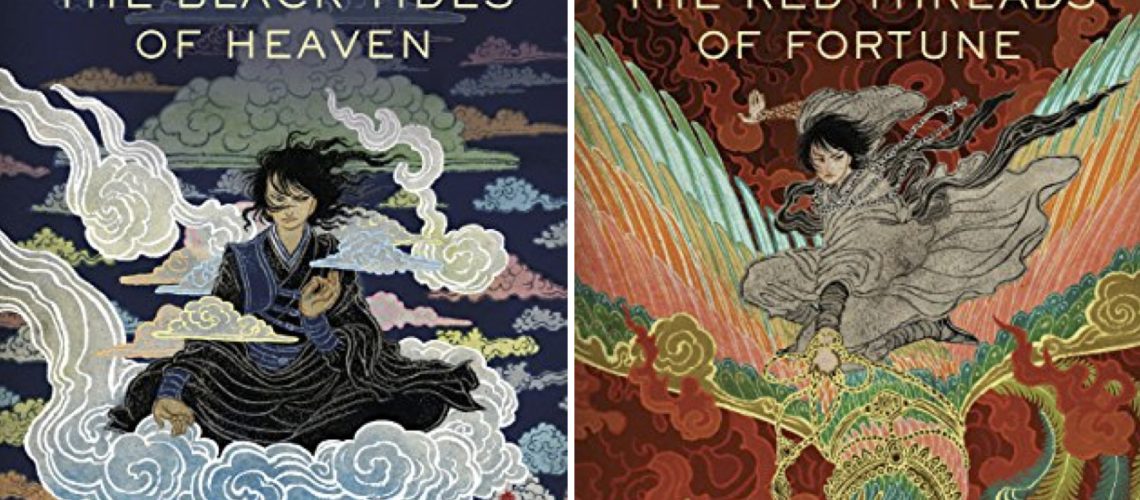Releasing books in a series in quick succession is nothing new. An author sells multiple volumes, already written, which come out in relatively short order with each other. It is far far less common, however, for a publisher to release multiple works by an author at the same time. It’s even rarer to have a pair of twinned works, who inform and influence each other. In The Black Tides of Heaven and The Red Threads of Fortune, two entangled novellas have been released by a new talent on the SF scene, JY Yang.
In the two novellas, Yang creates a strange fantasy world of mythical monsters, gender choice, autocratic overlords, coming of age stories, revolution, rebellion and much more. Between the two novellas, Mokoya and Akeha, twins, confront all of this and more within two stories. The world that the novellas create is Asian in focus and flavor and evocation, with monasteries, wuxia type feats, names, and more. And yet there are plenty of other elements that do not fall commonly in any sort of fantasy tradition, like, for example, dinosaurs. Yang incorporates a dizzying amount of invention and ideas into the fantasy world of the novellas. There’s an intriguing magic system (which itself is questioned and deconstructed in the second novella), polities, and vividly described and evoked locations and setting elements. From the 800 steps up to the Grand Monastery to the strangely rising and falling sun (the sun rises above and descends below the horizon in what we would consider a rapid fashion), this is a fantasy world that definitely seeks to stand apart.
 The novellas are very different in their focuses, though. The Black Tides of Heaven tells the early history of the siblings, how they are sold to the Grand Monastery, grow up, choose their paths (and have those choices thrown upon them) and eventually come to realize the nature of their mother’s oppressive Protectorate. There is a love story, entanglements between twins, a mother and ruler’s schemes, prophecy, foreshadowing and the limits of destiny. As unconventional as these two narratives are, it is the novella with the more familiar elements, and also does more of the heavy lifting in introducing aspects of the setting, especially the more unusual ones.
The novellas are very different in their focuses, though. The Black Tides of Heaven tells the early history of the siblings, how they are sold to the Grand Monastery, grow up, choose their paths (and have those choices thrown upon them) and eventually come to realize the nature of their mother’s oppressive Protectorate. There is a love story, entanglements between twins, a mother and ruler’s schemes, prophecy, foreshadowing and the limits of destiny. As unconventional as these two narratives are, it is the novella with the more familiar elements, and also does more of the heavy lifting in introducing aspects of the setting, especially the more unusual ones.
In The Red Threads of Fortune, some years later, the consequences of Mokoya’s prophetic abilities, and the tragedy of that and how it has played out, has estranged the twins. Now, Mokoya ranges across the wastelands, hunting naga, and avoiding,as much as she can, all that she used to love and hate and fear. It becomes a story of reconciliation, and coming to terms with the events that forged her in the previous novella, and finding that the path she has chosen in the wake of that tragedy need to be turned to a new one. A lot of what gets introduced in Black Tides of Heaven is taken here for granted, as written, and a lot of new setting elements, and a wider canvas is provided. Black Tides has a relatively narrow focus, Red Threads goes for a much wider story.
A theme in both of these novellas, perhaps the *point* of the novellas from my reading point of view, is that of choice. The world of the novella makes this upfront and clear with the idea that gender in this world is made to be a choice. Children are born without gender, and even the language of this world, with pronouns and particles delineated by gender, reinforce and confirm the idea that children are neither male nor female. At some point in their growth, a choice is made, and the child is confirmed as a man or a woman. There is a mention of “confirmation doctors” so it’s clear that this is not merely a question of gender identity, but full on gender itself. And the idea of this choice is even explored and dissected in The Red Threads of Fortune. But beyond gender, there are choices in the relationship between the siblings, to their mother, to their friends, allies, lovers and beliefs. When threatened at one point with death for a lack of cooperation, Akeha calmly replies “Accepting Death is also a choice.”
For all of the interesting worldbuilding, in manners great and small, one thing near and dear to my heart did annoy me no end, and that is the map. Yes, the novellas make it clear that even the laws of physics are somewhat out of kilter in Yang’s fantasy world (there are mentions of places where gravity differs from the norm). Sure, there is very strange and unusual magic at play in this world. And yet, given all this, one look at the map and I cringed. The map features multiple rivers splitting up on their way to the sea. Rivers, in a recognizable world, simply do not do the things they do on this map without major intervention. Sure, given the nature of the world, perhaps the Protector engages in massive continual projects to create these branch rivers. It is indeed possible but for me as a student of maps, demands an explanation not forthcoming in the text.
I do think, though, that for the protestations that the novellas could be read in either order, I think of this as halves of a greater whole, set in chronological order. The story for me makes more sense read and thought about in that straightforward fashion. Or at the very worst, these together are like one of the old Ace doubles, where two short works revolving around the same theme (by different authors usually) were paired together in a single volume. Together, these two novellas tell the story of a pair of interesting siblings in an interesting world.







